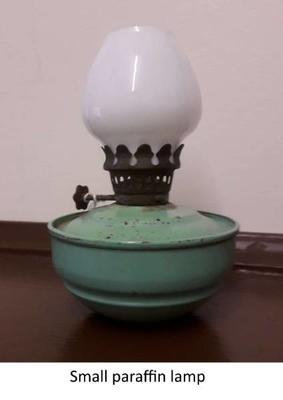
The History of Charlbury through ...lighting - candles and lamps
Ann Lovett for Charlbury Museum
Have you ever thought about what it would be like to live without electricity? As it gets dark of an evening we just flick the switch to turn on the lights, but lighting our homes hasn’t always been so easy.
In the museum is a medieval cresset lamp. It is a stone with hollows created in it which are filled with fat or oil. Floating wicks are added which can be lit as required. They were often used in religious houses. Interestingly the one in the museum was discovered in a wall between two houses in Hixet Wood.
Candles were the main form of lighting up to the 19C, along with light from the fire, and there were different grades of candle. Rush lights were made by repeatedly coating a rush in hot fat, building up the layers. This could be lit at the top or the bottom…hence the phrase 'burning the candle at both ends' .
Tallow candles were made of animal fat, preferably cow or sheep. These candles would be brown in colour and smelt, not very pleasantly, when lit. The wick would need frequent trimming. Beeswax candles were much better quality, gave a clearer light, smelt better, but were more expensive.
Later oil or paraffin lamps came into use. There are examples of these in the museum. Their flame had a glass protective cover.
Looking at the inventories we have for Charlbury pre 1858 , many listed candlesticks. These were usually brass or pewter, though 2 innholders had 7 and 8 tin candlesticks respectively. A few inventories had snuffers listed too. For instant, John Lewes , weaver, who died 1611 had 2 pewter candlesticks, whilst John Freeman 1829 had 3 candlesticks and 2 snuffers. The first lamps listed were those belonging to the Reverend Silver who died in 1854. He had a lamp and chain, a large street lamp and a hall lamp and chain.
Candles could be bought in the shops. There is a 1685 inventory for Alexander Aldworth which lists In the Shop Candles and Tallow 1l 10s.
We use candles and lamps today, and they give a soft light and lovely ambiance but when they were the main light source as in the past, it must have been hard to work indoors, especially in the darker winter months. The risk of fires with the open flames must have been high. The use of candles and lamps continued well into the 20thC, as even with the advent of electricity, many houses just had electric lighting downstairs. Mary Leech came to live in Charlbury after World War II and rented rooms on Dyers Hill where she remembers oil lamps were used.
The story of lighting will be continued in future postings.





